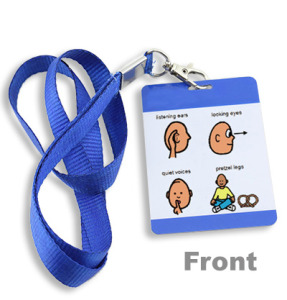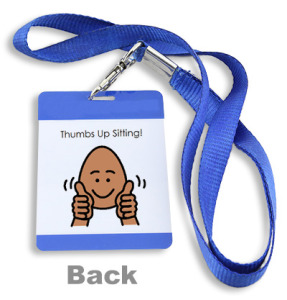How can teachers encourage and reinforce expected behaviors?
Page 6: Providing Positive Feedback
 In addition to reminders, teachers should provide positive feedback—verbal or non-verbal (e.g., smile, thumbs-up) affirmations—to children when they follow the rules. The purpose of positive feedback is to increase the likelihood that children will engage in appropriate behavior. Children who struggle with the rules need this positive feedback the most. It is important to comment right away when these children follow the rules, no matter how simple it seems. This feedback is critical to their improvement and success. There are a few key principles that should be followed when providing positive feedback. Feedback should be:
In addition to reminders, teachers should provide positive feedback—verbal or non-verbal (e.g., smile, thumbs-up) affirmations—to children when they follow the rules. The purpose of positive feedback is to increase the likelihood that children will engage in appropriate behavior. Children who struggle with the rules need this positive feedback the most. It is important to comment right away when these children follow the rules, no matter how simple it seems. This feedback is critical to their improvement and success. There are a few key principles that should be followed when providing positive feedback. Feedback should be:
“Speak a word of affirmation at the right moment in a child’s life and it’s like lighting up a whole roomful of possibilities.”
Gary Smalley
- Based on appropriate behavior or on the child’s effort towards the appropriate behavior
- Descriptive of the child’s desired behavior
- Sincere and conveyed with enthusiasm
- Provided frequently, especially for children who have trouble following the rules
- Individualized based on the child’s needs (e.g., visual supports, verbal statements, close proximity) and preferences (e.g., whether the child is comfortable being praised in front of others or prefers private recognition)
The most powerful positive feedback is behavior-specific praise or descriptive praise—a positive declarative statement directed toward a child or group of children that describes a desirable behavior in specific, observable, and measurable terms. This involves saying the child’s name and telling him or her exactly what was done correctly.
Examples: “Wow! Bianca, you washed your hands all by yourself! You didn’t need any reminders!” or “Harper and Reagan, thank you for following directions and pushing in your chairs!”
Non-examples: “Good job!” or “Thank you, friends!”
Did You Know?
When a teacher provides behavior-specific praise for a child, often times other children will hear and engage in that behavior as well. For example, the teacher directs the class to clean up for the transition and provides behavior-specific praise to a few children who immediately follow directions: “Micayla and Patrick, fantastic job cleaning up the art studio and throwing away your trash!” The teacher says this in a voice loud enough for the other children to hear. She gives all children who subsequently clean up a high-five when they line up at the door for the transition outside.
Research Shows
- Praise is one of the most effective school-based strategies that teachers can use to decrease problem behavior and increase positive behavior.
(Cavanaugh, 2013) - A general 4:1 ratio of praise to reprimand statements is desirable. Another recommendation is using about six praise statements every 15 minutes.
(Myers, Simonsen, & Sugai, 2011; Piscareta, Tincani, Connell, & Axelrod, 2011)
Sometimes, teachers must intensify their efforts to offer positive feedback, particularly with children who struggle with the rules. Teachers can acknowledge individual or group progress and success in following classroom rules by:
 Sending a positive note home with the child
Sending a positive note home with the child- Making a positive phone call home
- Taking a photo of a child in the act of following a rule and putting it on the wall next to the posted rule
- Writing the child’s name, what she or he did, and the date on a handprint or classroom symbol, which is then posted on the wall or a bulletin board
- Giving a classroom cheer (e.g., “I saw D’Onte, April, and Charise waiting so safely for the slide. Let’s give a big cheer!”)
- Giving the child a stamp on her or his hand or a small sticker
- Letting the child be the line leader or teacher’s special helper for the day
Revisit Mrs. Rodriguez's Classroom
Mrs. Rodriguez decides to create a system for communicating with children during group time about whether they are following classroom rules. In the past, she had difficulty offering praise during group time without stopping the activity completely. To overcome this problem, Mrs. Rodriguez constructs a necklace that has the rules on one side and a thumbs-up picture on the other. By showing the appropriate side of the necklace, she can gently—and silently—remind her children about the desired behavior if they are not following the rules during an activity, or provide them with positive reinforcement if they are doing what they should.
Credit
The Picture Communications Symbols ⓒ1981-2014 by Mayer-Johnson LLC. All Rights Reserved Worldwide. Used with permission.
For Your Information
Teachers must monitor their own behavior, using self-management strategies, to ensure that they are providing more positive feedback than giving directions or correcting inappropriate behavior. There are different strategies teachers can use to monitor their own behavior:
self-management strategy
A strategy an individual can use to independently monitor, analyze, and direct her or his own behavior without the assistance of others.
- Put a number of rubber bands on one wrist and move each rubber band to the other wrist whenever they provide a positive descriptive comment to a child, with the goal of moving all the rubber bands over in each activity or routine of the day.
- Tally the number of times positive feedback is used during the day on a sticky note, the board, or a clipboard.
- Use a timer to cue oneself to provide positive feedback at regular intervals.
- Ask a coworker to count the number of times the teacher uses positive feedback.

